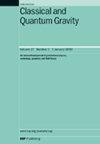具有热波动和非线性电磁场的爱因斯坦-欧拉-海森堡黑洞热力学
IF 3.6
3区 物理与天体物理
Q2 ASTRONOMY & ASTROPHYSICS
引用次数: 0
摘要
本工作主要从各个方面介绍非线性爱因斯坦-欧拉-海森堡理论及其应用。首先,以霍金-贝肯斯坦熵为基础,利用Smarr公式解析确定四维球对称爱因斯坦-欧拉-海森堡黑洞的热力学变量。这些结果得到了某些欧拉-海森堡参数和电荷参数的图解支持,这些参数反过来又用于进一步评论有关黑洞的稳定性和可能的临界点。热力学分析然后在两个不同的情况下重复,其中熵分别受到对数和指数修正。我们的评估表明,统计量子涨落和非线性电动力学效应可以改变黑洞的稳定性和热力学性质。最后,根据非线性爱因斯坦-欧拉-海森堡模型确定了天体结构附近的单侧弯曲角和光的引力红移,并将所得结果应用于三颗带电致密恒星。本文章由计算机程序翻译,如有差异,请以英文原文为准。
Thermodynamics of Einstein–Euler–Heisenberg black holes with thermal fluctuations and nonlinear electromagnetic fields
This work mainly focuses on the nonlinear Einstein–Euler–Heisenberg theory and its applications from various aspects. Firstly, thermodynamic variables are analytically determined via Smarr formula for a four-dimensional spherically symmetric Einstein–Euler–Heisenberg black hole by taking the Hawking–Bekenstein entropy as the basis. The results are supported by graphical illustrations for certain Euler–Heisenberg and electric charge parameters, which are in turn used for making further comments on the stability and possible critical points of the concerned black hole. The thermodynamic analyses are then repeated for two distinct cases in which entropy is subject to a logarithmic and an exponential correction, respectively. Our assessments have shown that statistical quantum fluctuations and nonlinear electrodynamic effects can alter the stability and the thermodynamic properties of black holes. Finally, the one-sided bending angle and the gravitational redshift of light are determined in the vicinity of astronomical structures obeying the nonlinear Einstein–Euler–Heisenberg model and the results obtained are applied to three electrically charged, compact stars.
求助全文
通过发布文献求助,成功后即可免费获取论文全文。
去求助
来源期刊

Classical and Quantum Gravity
物理-天文与天体物理
CiteScore
7.00
自引率
8.60%
发文量
301
审稿时长
2-4 weeks
期刊介绍:
Classical and Quantum Gravity is an established journal for physicists, mathematicians and cosmologists in the fields of gravitation and the theory of spacetime. The journal is now the acknowledged world leader in classical relativity and all areas of quantum gravity.
 求助内容:
求助内容: 应助结果提醒方式:
应助结果提醒方式:


